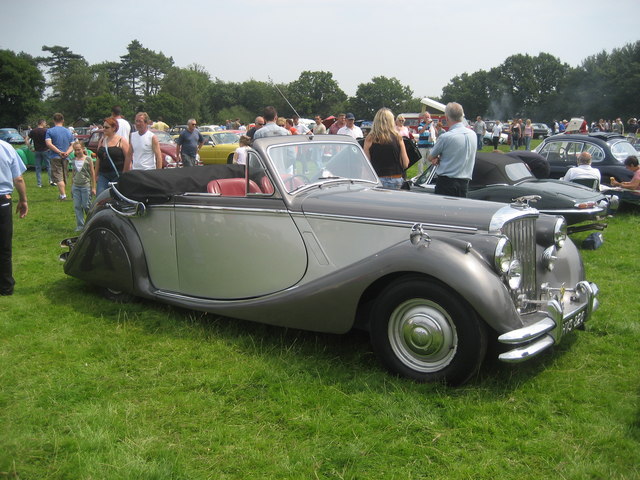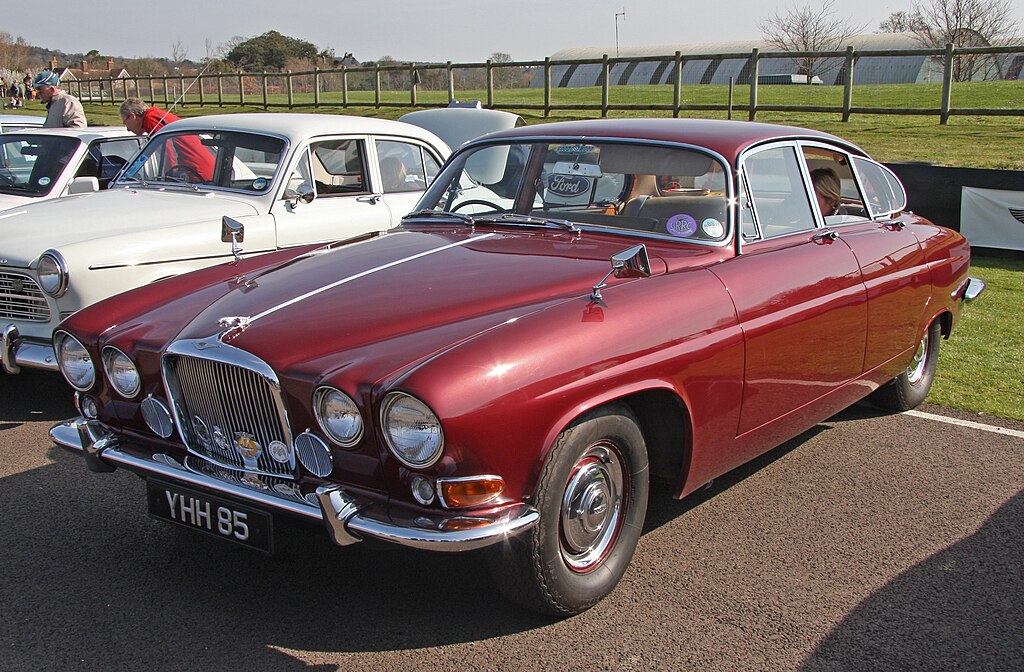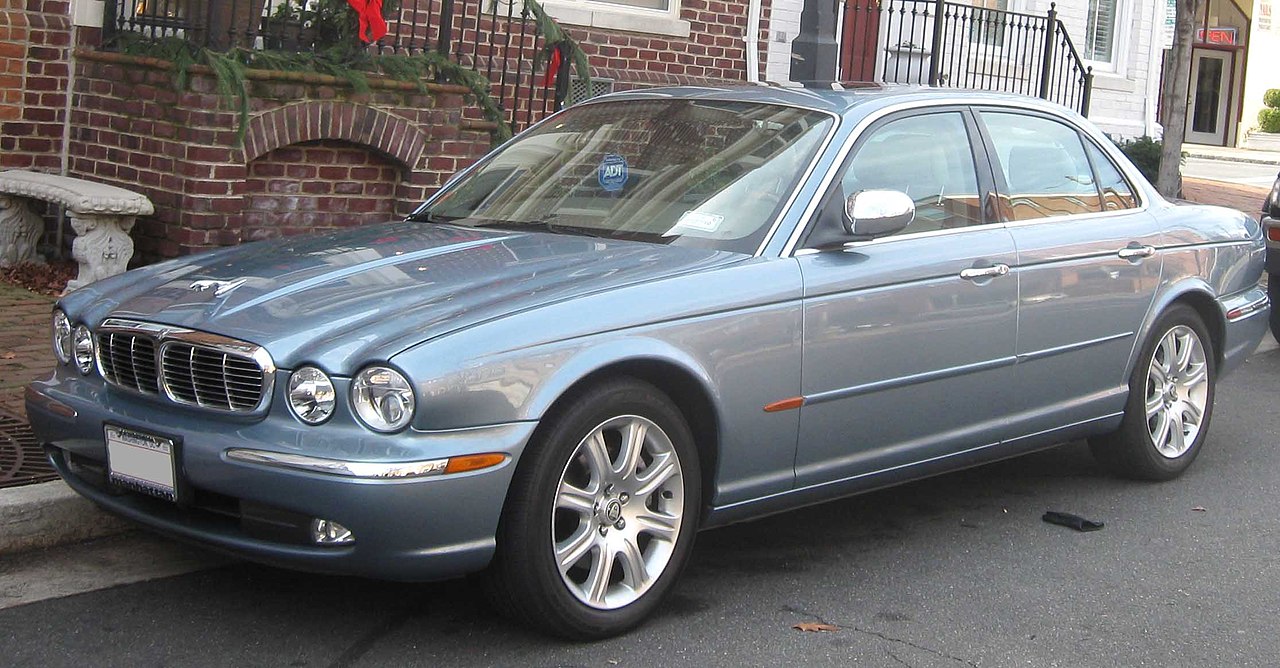1935–1955 2½ Litre saloon
The Jaguar Mark IV (pronounced mark four) is a range of automobiles built by Jaguar Cars from 1945 to 1949. The cars were marketed as the Jaguar 1½ litre, Jaguar 2½ litre and Jaguar 3½ litre with the Mark IV name later applied in retrospect to separate this model from the succeeding Mark V range.
The range was a return to production of the SS Jaguar 1½ litre, 2½ litre and 3½ litre models produced by SS Cars from 1935 to 1940. Before World War II the model name Jaguar was given to all cars in the range built by SS Cars Ltd with the saloons titled SS Jaguar 1½ litre, 2½ litre or 3½ litre and the two-seater sports cars the SS Jaguar 100 2½ litre or 3½ litre. In March 1945 the company name SS Cars Ltd was changed to Jaguar Cars Ltd.
1937–1948 3½ Litre saloon
The Jaguar Mark IV (pronounced mark four) is a range of automobiles built by Jaguar Cars from 1945 to 1949. The cars were marketed as the Jaguar 1½ litre, Jaguar 2½ litre and Jaguar 3½ litre with the Mark IV name later applied in retrospect to separate this model from the succeeding Mark V range.
The range was a return to production of the SS Jaguar 1½ litre, 2½ litre and 3½ litre models produced by SS Cars from 1935 to 1940. Before World War II the model name Jaguar was given to all cars in the range built by SS Cars Ltd with the saloons titled SS Jaguar 1½ litre, 2½ litre or 3½ litre and the two-seater sports cars the SS Jaguar 100 2½ litre or 3½ litre. In March 1945 the company name SS Cars Ltd was changed to Jaguar Cars Ltd.
1948–1951 Mark V
The Jaguar Mark V (pronounced mark five) and always printed in company documents as a Roman numeral V, never an Arabic number 5, is an automobile built by Jaguar Cars Ltd from 1948 to 1951.
The Mark V was introduced to distributors and the press on 30 September 1948 and launched on 27 October 1948 at the London Motor Show at the same time as the XK120, with which it shared a stand. The XK120 stole the show. However, the Mark V vastly outsold the XK120 by roughly 5,000 cars per year as compared to 2,000 cars per year for the XK120. While the XK120 had a new overhead-camshaft XK engine, the Mark V retained the 1946-48 driveline including the overhead-valve pushrod straight-6 2½L and 3½L engines, now since 1946 produced by Jaguar, which the company had previously purchased from the Standard Motor Company before the war, and the four-speed single-helical gearbox produced by both Jaguar and the Moss Gear Company of Birmingham. The 1½L Standard engine used in previous models was not offered in the Mark V. Claimed power output in this application was 104 bhp (78 kW) for the 2664 cc Mark V and 126 bhp (94 kW) for its more popular 3486 cc sibling. The chassis was new with independent front suspension by double wishbones and torsion bar, an arrangement that would be used by Jaguar for many future vehicles. It also had hydraulic brakes, which Jaguar had been slow to adopt compared to other manufacturers, and an all pressed steel body.
1951–1957 Mark VII (& VIIM)
The Jaguar Mark VII is a four-door luxury car produced by Jaguar Cars of Coventry from 1951 to 1956. Launched at the 1950 British International Motor Show as the successor to the Jaguar Mark V, it was called the Mark VII because there was already a Bentley Mark VI on the market.[citation needed] A version of the Jaguar Mark V with the XK engine had been designated as the Mark VI, but it is thought that only two were built.
In its original 1950 form the Mark VII could exceed 100 mph, and in 1952 it became the first Jaguar to be made available with an optional automatic transmission.
1957–1959 Mark VIII
The Jaguar Mark VIII is a large four-door sports sedan introduced by the Jaguar company of Coventry at the 1956 London Motor Show.
1959–1961 Mark IX
The Jaguar Mark IX (pronounced mark nine) is a large luxury saloon car produced by Jaguar Cars between 1959 and 1961. It replaced the previous Mark VIII. The early versions were identical in exterior appearance to the Mark VIII except for the addition of a chrome "Mk IX" badge to the boot lid. Later versions had a larger tail-lamp assembly with the addition of an amber section for traffic indication, visually similar to the tail-lights of the smaller Jaguar Mark 2. It was replaced by the lower and more contemporary-styled Mark X in 1961.
1961–1966 Mark X
The Jaguar Mark X (Mark ten), later renamed the Jaguar 420G, was British manufacturer Jaguar's top-of-the-range saloon car for a decade, from 1961 to 1970. The large, luxurious Mark X succeeded the Mark IX as the company's top saloon model, and was primarily aimed at the United States market. The company hoped to appeal to heads of state, diplomats and film stars.
1966–1970 420G
The Jaguar Mark X (Mark ten), later renamed the Jaguar 420G, was British manufacturer Jaguar's top-of-the-range saloon car for a decade, from 1961 to 1970. The large, luxurious Mark X succeeded the Mark IX as the company's top saloon model, and was primarily aimed at the United States market. The company hoped to appeal to heads of state, diplomats and film stars.
1968–1987 XJ6 Series 1, 2 & 3
The Jaguar XJ is the name of a series of full-size luxury cars sold by the British automobile brand, Jaguar Cars since 1968. Since 1970 they have been Jaguar's flagship. The original model was the last Jaguar saloon to have had the input of Sir William Lyons, the company's founder, and the model has been featured in countless media and high-profile appearances. The current Jaguar XJ was launched in 2009. It is one of the cars used by the British royal family and an armoured version is used for transporting the UK Prime Minister.
1972–1992 XJ12
The Jaguar XJ is the name of a series of full-size luxury cars sold by the British automobile brand, Jaguar Cars since 1968. Since 1970 they have been Jaguar's flagship. The original model was the last Jaguar saloon to have had the input of Sir William Lyons, the company's founder, and the model has been featured in countless media and high-profile appearances. The current Jaguar XJ was launched in 2009. It is one of the cars used by the British royal family and an armoured version is used for transporting the UK Prime Minister.
1986–1994 XJ6 (XJ40)
The Jaguar XJ (XJ40) is a luxury sedan manufactured by Jaguar Cars between 1986 and 1994. Officially unveiled on 8 October 1986 it was an all-new redesign of the XJ to replace the Series III, although the two model ranges were sold concurrently until the Series III was discontinued in 1992. The XJ40 used the Jaguar independent rear suspension arrangement, and featured a number of technological enhancements (such as electronic instrument cluster).
1995–1997 XJ6 & XJ12 (X300 & X301)
The Jaguar XJ (X300) is a luxury sedan manufactured by Jaguar Cars between 1994 and 1997. It was the first XJ produced entirely under Ford ownership, and can be considered an evolution of the outgoing XJ40 generation. Like all previous XJ generations, it features the Jaguar independent rear suspension arrangement. The design of the X300 placed emphasis on improved build quality, improved reliability, and a return to traditional Jaguar styling elements.
1998–2003 XJ8 (X308)
The Jaguar XJ (X308) is a luxury saloon manufactured and sold by Jaguar Cars between 1997 and 2003. It is an evolution of the outgoing X300 platform, and the exterior styling is nearly identical between the two generations. The major change was the introduction of Jaguar's AJ-V8 as the only available engine. Like all previous XJ generations, it features the Jaguar independent rear suspension arrangement.
2004–2007 XJ (X350)
The Jaguar XJ (X350) (2003–2006) is a full-size four-door, front-engine, rear-drive luxury sedan/saloon manufactured and marketed by Jaguar Cars for model years 2003–2009 as the third generation of the Jaguar XJ sedan – with an intermediate facelift in 2007.
The XJ was noted for its fully aluminum monocoque bodywork – with 20 yards of bonding aeronautic adhesive and approximately 3200 self-piercing rivets – yielding a curb weight of 1,539 kg (3,393 lb) in its lightest configuration.
2008-2009 XJ (X358)
The X350 was facelifted for the 2008 model and unveiled at the end of February 2007. The car featured a mildly revised front grille and new front bumper assembly with a prominent lower grille. A Jaguar emblem within the grille replaced the previous bonnet-mounted hood ornament. The front lights had detail changes while the revised door mirrors incorporated side repeaters. The front wings featured side vents, and the side sills, rear bumper and tail lights were revised.
The interior featured redesigned front seats with additional support and providing rear passengers over a metre of legroom


_(8051567557).jpg)
_(14268238138).jpg/1024px-SS_Jaguar_1.5Litre_(1937)_(14268238138).jpg)
_(14445911884).jpg/1024px-SS_Jaguar_1.5Litre_(1937)_(14445911884).jpg)



_(10275785216).jpg/1024px-Jaguar_Mk_IV_3%C2%BD_Litre_(1948)_(10275785216).jpg)


_at_Schaffen-Diest_rear_three_quarters.JPG/800px-Jaguar_Mark_V_(1949)_at_Schaffen-Diest_rear_three_quarters.JPG)
.jpg/800px-1949_Jaguar_MK_V_DHC_(3736344067).jpg)






_(8999143979).jpg/1024px-Jaguar_Mk_IX_(1960)_(8999143979).jpg)
_(8999143935).jpg/1024px-Jaguar_Mk_IX_(1960)_(8999143935).jpg)



.JPG/800px-'63_Jaguar_Mark_X_(Hudson).JPG)


.png/1024px-Royal_car_NGN2_at_Liverpool_-_scan01_(cropped).png)
_4.2_SWB_sedan_(2015-08-02)_01.jpg/1024px-1973_Jaguar_XJ6_(Series_I)_4.2_SWB_sedan_(2015-08-02)_01.jpg)
_4.2_SWB_sedan_(2015-08-02)_02.jpg/1024px-1973_Jaguar_XJ6_(Series_I)_4.2_SWB_sedan_(2015-08-02)_02.jpg)


.jpg/800px-Jaguar_XJ6_4.2_Series_III_(14851444111).jpg)



_(cropped).jpg/1024px-1992_Jaguar_XJ6_(5065582932)_(cropped).jpg)


_sedan_(2011-11-18)_01.jpg/1280px-1991-1994_Jaguar_Sovereign_(XJ40)_sedan_(2011-11-18)_01.jpg)
.jpg/1280px-1990_Jaguar_VdP_Majestic_(US).jpg)


_(cropped).jpg/1920px-Jaguar_Sovereign_4.0_1997_(15459823759)_(cropped).jpg)




_rear_20100515.jpg/1024px-Daimler_Super_V8_(X308)_rear_20100515.jpg)


_%E2%80%93_Frontansicht%2C_17._April_2011%2C_D%C3%BCsseldorf.jpg/1280px-Jaguar_XJ_2.7_D_(X350%2C_Facelift)_%E2%80%93_Frontansicht%2C_17._April_2011%2C_D%C3%BCsseldorf.jpg)
_%E2%80%93_Heckansicht%2C_17._April_2011%2C_D%C3%BCsseldorf.jpg/1280px-Jaguar_XJ_2.7_D_(X350%2C_Facelift)_%E2%80%93_Heckansicht%2C_17._April_2011%2C_D%C3%BCsseldorf.jpg)





.jfif)


No comments:
Post a Comment